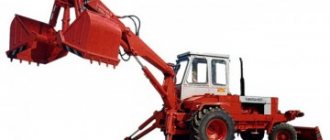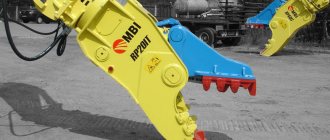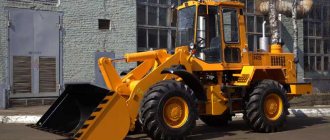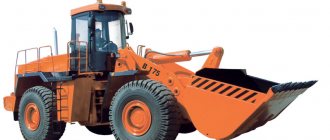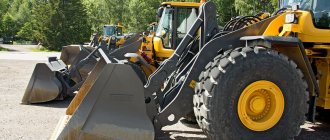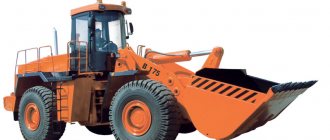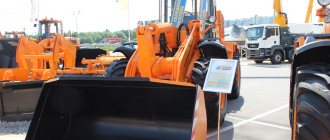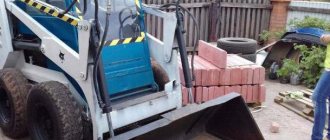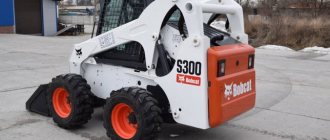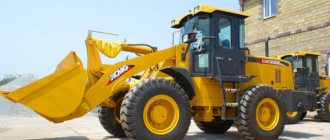The T-16 grab loader is designed for loading and unloading of any non-bulk or bulk (if an appropriate bucket is installed) materials. It is based on the chassis of the T-16 tractor produced by KhTZ (Kharkov Tractor Plant), on which mounted loading equipment of the PG-0.2A brand is installed.
Currently, serial production of the base tractor has been discontinued, but a loader based on the T-16 can be mounted on the basis of another tractor with a rear engine or a truck.
Reinforced grab loader-excavator PEF-1BM
Technical characteristics of PEF-1BM
Beware of fakes
There are fakes of extremely low quality on the market, including black and green colors. Be sure to check the manufacturer when purchasing forklifts from sellers.
Universal grab loader-excavator PE-F-1BM
designed to perform the widest range of work in agriculture, indispensable in construction and public utilities. PE-F-1BM-1 is especially popular among farmers: equipped with grab forks, it is capable of quickly reloading hay, manure and other organic fertilizers for further transportation, processing, disposal, application and storage. Our loader is also successfully used in small and medium-sized construction work, and especially in the housing and communal services sector.
Double the performance
Compared to front-end loaders (with an average productivity of 50-60 tons/hour), thanks to the wide working sector of the manipulator (160 degrees) and the large capacity of the grab (0.56 m 3), the productivity of PE-F-1BM-1 reaches an impressive 120 t/h
! The work is carried out in a semi-stationary mode - this allows you not to waste time constantly moving equipment in the process.
Versatility and multifunctionality
In addition, the PEF-1B M loader is very multifunctional - due to additional working parts, including a clamshell bucket and claws, an excavator shovel and even a hook, its scope of application is significantly increased. This includes digging holes and trenches up to 3.5 meters deep, reloading bulk materials and garbage collection, loading and moving packaged cargo weighing up to 1 ton to a height of up to 5.3 meters. A mandatory two-meter bulldozer blade installed (used as a third point of support in a stationary mode) allows for planning and cleaning work. But you never know what else you might need to do on the farm!
Perhaps the most reliable machine in its class, the MTZ tractor, is used as a mobile base for the PE-F-1BM. The PE-F-1B modification is aggregated with YuMZ and ZTM tractors. With a length of 6 meters and a width of 2.25 meters, the loader is compact enough to be used in a relatively small space or in a confined construction site.
Convenience and ease of maintenance
The design of our loader is designed taking into account the possibility of quickly replacing working parts and maximizing simplification of routine maintenance work: grease fittings for lubrication (injection) are provided at all points of the hinge joints, places for lubrication and drawing of threaded connections are freely accessible and clearly marked in the accompanying documentation. And replacing the working element is a routine operation - it is carried out by one person and does not require adjustments to the operation of mechanical components or the hydraulic system. Thus, the qualifications of an operator or mechanic are more than enough to carry out such manipulations independently.
Maximum Stamina
The materials used in the appropriate grades (steel 09G2S and 45 followed by hardening with high-frequency heat and tempering in a furnace) and design solutions accumulated through production experience make our PEF-1BM excavator loader extremely durable and durable even during intensive use in difficult conditions!
The reinforced column is made in the form of a thick-walled square box with additional side linings, which prevents it from folding. Throughout the entire structure, additional point reinforcements were made along dangerous sections and in places of maximum load. For support under the column, a solid cast bollard with straight single-pass boring is used - this guarantees the absence of misalignment and, as a consequence, premature failure of the rack-and-pinion hydraulic cylinder and column gear.
Modern Italian hydraulics
The hydraulic system uses Italian components (locks, dampers, filters, etc.). There is a temperature control sensor, as well as a filler and main filter in the hydraulic tank. The hydraulic system is driven from the tractor PTO through a gearbox (with NSh-32 pumps) or directly with the NSh-100 pump (without gearbox).
By ordering a PEF-1BM grab loader from our company, you will receive truly reliable multi-purpose equipment suitable for solving a wide range of tasks!
Device
The technical characteristics of the Karpatets loader allow you to perform many serious jobs. Uninterrupted operation of the unit is ensured by:
- The four-stroke piston internal combustion engine is equipped with four cylinders, without turbocharging.
- Italian hydraulics, where control is carried out using joysticks, while the force of the hydraulic cylinders is enough for loading and unloading and digging soils of any category of complexity. Two pumps are located at the rear of the gearbox, two on the engine.
- The functionality of the unit is enhanced by such removable mechanisms as forks, hooks, boom extension, and excavator shovel.
- The operator's comfort is created by a cabin equipped with air conditioning, windshield wipers, a sun visor, and a rearview mirror. The seat mount is equipped with shock-absorbing springs.
Model overview
There are different models of grab loaders available. Let's look at the most popular grab loaders that are most often used.
Karpatets PEA 1A
Karpatets PEA 1A is designed for loading, excavating and leveling work. It is used when greater lifting capacity, speed and boom reach are needed. The mechanism performs work without moving due to the large angle of rotation of the boom.
- Loading capacity - 1 t.
- The grab volume is 0.67 m³.
- Productivity - 240 t/h.
- Turning radius - 270º.
- The loading height with a grab is 4.3 m.
- The maximum digging depth with an excavator shovel is 2.5 m.
- The volume of the excavator shovel is 0.44 m³.
- The width of the excavator shovel is 0.7 m.
- The width of the bulldozer blade is 2.45 m.
- The height of the bulldozer blade is 0.73 m.
- Ground clearance - 0.4 m.
- Travel speed is 25 km/h.
- Dimensions - 6.75x2.20x2.67 m.
- Weight - 7575 kg.
Based on MTZ
A trailed loader based on MTZ is used for loading bulk and large-sized materials or cargo using a grab. Grab loaders are manufactured on the basis of MTZ. The machines are manufactured on the basis of the MTZ-80 and MTZ-82 tractors, using attachments such as a grab bucket and pneumatic wheels. Such units can operate in a limited area.
They are easy to repair and maintain, since spare parts are inexpensive and always available. Some models based on the MTZ tractor may have a telescopic boom, which increases the digging depth. Such machines are used for digging deep pits, lifting and transporting bulk materials and oversized objects. They are also used to clean water bodies.
- Load capacity - 1000 kg.
- Weight - 2.4 tons.
- Width - 2.25 m.
- Length - 5.5 m.
- Engine power - 60 hp.
- Fuel consumption - 238 l/h.
- Speed - 19 km/h.
- The grab volume is 0.56 m³.
- The volume of the excavator shovel is 0.27 m³.
- Loading height - 3.7 m.
- The maximum lowering of the grab below the support with a simple boom is 2.5 m; with telescopic boom - 3.5 m.
Based on T-16
A grab loader based on the T-16 is used for loading operations, moving cargo or bulk materials. The unit is installed on the chassis of the T-16 tractor from the Kharkov Tractor Plant.
- The location of the mounted loader is at the front.
- Loading height - 3.52 m.
- The grabber capacity is 0.56 m³.
- Dimensions - 4570x2500x3300 mm.
- Weight - 1.25 tons.
- Diesel engine 25 hp
- Speed - 16 km/h.
Other models
The PG 02 loader is designed for loading bulk, piece and other cargo into vehicles, as well as for performing leveling work and raking material. The set includes a grab for root crops, used in agriculture. The mechanism is compatible with the T-16 or SSh-28 chassis.
- load capacity - 2.8 kN;
- productivity when loading sand - 53 t/h;
- speed - 16 km/h;
- ground clearance - 290 mm;
- turning radius - 5570 mm;
- boom radius - 1720 mm;
- loading height - 3520 mm;
- Grab lowering depth - 1600 mm;
- boom rotation angle - 180º;
- grab volume for bulk cargo - 0.2 m³;
- dimensions - 6150x3900x4720 mm.
Specifications
Workers of the design bureau, having modernized the previous model, developed the Karpatets PEA 1A. By reducing the total weight by 15%, they increased the maneuverability and carrying capacity of the equipment.
The improved model has the following indicators:
- Length 6 meters, width 2.25 meters, height - almost 4 meters
- Clearance height from the surface is 0.4 meters
- The maximum speed of movement of the unit in operation is 25 km/h
- Loader boom throw length reaches 4.5 meters
- With a maximum digging radius of 5 meters, the trench depth reaches 2.5 meters
- The volume of an excavator shovel reaches 0.7 m3
- Grab bucket volume—0.56 m3
- Total lifting capacity is 1 ton
- Engine D 243
- Specific fuel consumption – 245 G/kW*hour
How to make it yourself
A homemade hand grab is not difficult to make.
Materials and tools:
- steel 2 mm thick;
- pipes of different diameters;
- chain;
- welding machine;
- cutter.
A rectangular plate 550x22 mm is cut out of a steel sheet. It needs to be divided into 2 parts, cut not in a straight line, but in a zigzag. This will create teeth. Each tooth should be 15 mm long. Now the sides are done. The bottom plates should not be horizontal; an angle of 15º should be maintained between them and the ground.
Then plates are cut out 40 mm wide and 220 mm high. Then you need to step back 5 cm from the edge of the front part of the side and weld the plates so that they meet in the center of their edge. The plates at one end are welded to the outside of the side.
At the second edge they are welded onto the side. Then you need to trim them so that they are the same length. Now take the pipes, one should scroll inside the other. A hole is made in the ladle plates for the pipe. They put it in a plate and weld it. The same steps are performed for the second pipe.
Ballast of 5 kg on each side is welded at the ends. Handrails are attached. One chain is mounted to the center of the handrails. You need 2 chains 1 m long. They are attached to the edges of the central pipe. The other ends are connected and suspended on one chain.
Description[ | code]
Bridge material handler with double jaw rope grab
The device is a device consisting of a large iron scoop attached to a load-lifting crane and used to grab and unload material lifted by the crane - sand, earth, rocks, scrap metals.
Grabs are also working equipment for mechanical and hydraulic excavators and are used in the development of soils below and above the parking level, as well as some other types of work - digging deep pits, cleaning ponds and canals.
Options | code
The value of the crane's lifting capacity (indicated by “ Q
“), equipped with a grab, the weights of the load and the grab are included. The scooping ability of the grab depends on the ratio of these masses. In this regard, bulk cargo handled by a grab is divided according to bulk density into the following groups:
| Group | Bulk density (p), t/m³ | Description of goods | Grab weight |
| Very light | 0,4 — 0,63 | fluff lime, coal dust | 0.37Q |
| Lungs | 0,8 — 1 | dry powdered alumina and chalk, dry slag, fine and medium crushed stone, coal of all grades | 0.4Q |
| Average | 1,25 — 2 | small-piece gypsum, alabaster, dry small-piece clay, gravel, medium-piece limestone, broken brick, cement, coarse crushed stone | 0.42Q |
| Heavy | 2,5 — 3,2 | hard rocks | 0.45Q |
The lifting capacity of a grab is determined by weighing the material after a test scooping performed by the owner of the grab before using it for handling cargo of a given type (brand, grade). Test scooping is carried out from the horizontal surface of freshly poured soil. The grab ropes must be protected from chafing by the material grabbed by the grab.
The grab blocks are positioned and constructed in such a way as to prevent spontaneous opening and loss of ropes from the groove of the block.
MTZ-based grab loader - what is it and where is it used?
These devices are installed on tractors as attachments.
With the help of a rotating boom, materials can be loaded in any position of the loader.
Grab loaders based on MTZ tractors are produced by several factories and enterprises, the main manufacturer is the Yurga Agricultural Equipment Plant "Yurmash".
The main number of grab devices is installed on the base of agricultural models of tractors MTZ-80 and MTZ-82.1 , using the resources and performance of the Minsk “Belarus”.
MTZ tractors are distinguished by all-season operation and reliable mechanisms. Their high off-road capability is successfully combined with the ability to move on roads in general traffic.
Inexpensive and accessible spare parts are complemented by the versatility of using special equipment:
- loading sand, gravel, snow, construction and other waste and other materials into vehicles;
- excavation work (moving, laying and excavating soil), cleaning the area at a level that may be above or below the level of the car parking;
- digging large and deep (up to 2.5 m) pits with excavation of soil and stone;
- lifting, moving and reloading hay, silage, straw, peat and fertilizers;
- lifting long and oversized objects (timber);
- cleaning of shallow bodies of water (lakes, ponds). Features of the loader and its design
The most popular grab loader at MTZ is the PE-F-1BM; several modifications have been created on its basis.
The main advantages of the grab installation at MTZ:
- multifunctionality;
- favorable price-quality ratio;
- loading capacity = 120 t/hour;
- aggregation (arrangement) of a loader with tractors and trailers, which expands their scope of application;
- Possibility of operation in all weather conditions;
- maintainability and low cost of maintenance of the grab installation.
The grab is used for lifting, reloading and transport work with various materials or piece cargo up to 1 ton.
Basic equipment - grab bucket and bulldozer blade (straight type, width = 2 m).
Full set - plus forks (claws), volume = 0.56 m³ for hay, silage and backhoe (volume = 0.27 m³), reinforced high-strength grab, volume = 0.3 m³. As additional options, a hook with a capacity of 1 ton and a drill can be installed.
Cable cars
Let's start with single-rope units. Such loaders have replaceable load-handling devices. The grab is hung on a hook clip. The rope of the unit is both closing and lifting. The main feature of such devices is the presence of a lock that connects the traverse to the holder. The latter is made with pulley blocks. Typically, single-rope units have a bulk density from 500 kg to 2 tons per cubic meter.
Among the advantages of such devices is versatility. Due to the fact that the grab is hung on a hook, it can be installed on any tractor, excavator and even crane. But single-rope units also have a number of disadvantages. This is a low volume height (usually it does not exceed two and a half meters) and manual control of the opening of the apparatus’s jaws.
As for two-rope loaders, in such loaders the jaws are connected to the lower crossbar using a rod with a head. On the latter there is a lifting rope that lowers and raises the apparatus. This type of loader is driven by a winch. It can be driven by a single motor or by a clutch. To increase the cutting force, a rope is pressed into the pulley at the edges of both jaws. Blocks with clips of the latter are mounted on the head and lower cross-beam.
Among the advantages of two-rope devices, it is worth noting their high capacity. At one time, this loader can scoop up from two to twenty cubic meters of bulk material. All work is done automatically. When the jaws close, the winch operates itself. Among the disadvantages of such loaders, it is worth noting the inability to quickly replace the grab.
Grab loader based on T 16 - differences and technical parameters
The basic model T-16 was produced by the Kharkov Tractor Plant in 1961-1967.
Later the car was modified and was produced in an improved form until 1996.
Advantages of the HTZ chassis:
- Long service life.
- Low price.
- The tractor weighs 1685 - 1810 kg - it does not compact the top layers of soil.
- It has 2 pairs of wheels of different sizes - smaller front ones and larger rear ones; using the locking mechanism, you can change the track width for both pairs.
- The T-16 chassis has a rear-mounted engine and can be mounted with virtually any front-mounted equipment. There are seats for attachments at the front.
- Tractor engine 25 hp - air-cooled.
Disadvantages of the T-16 : low productivity and the need for regular cleaning of the air valves and centrifuge.
Classifications of grabs by jaw type
As mentioned above, the gripping elements of the grab are called jaws
.
Their number varies from two to eight. The shape of the jaws largely determines what loads the gripper can handle. Bucket grabs
are often used for digging and mining.
In order to improve scooping characteristics, the cutting edges of the bucket are supplemented with pointed teeth. Pincer grips
are convenient for loading round timber, pipes and other cylindrical objects of oblong shape.
Fork grabs
are used as agricultural equipment. They are indispensable for high-performance loading of hay, straw, silage and other fibrous materials, both in roll and loose form.
Bulk, small-piece and prone to spillage (leakage) cargo are reloaded using a closed
or
semi-closed
grab bucket.
Other types of cargo are handled by open grabs
, the blades of which do not form a continuous surface when closed.
Separately, it is worth paying attention to the trajectory of movement of the jaw grip. In digging devices, the jaws close along a “digging” trajectory, thereby allowing deeper penetration into the developed soil.
Blades moving along a raking path, on the contrary, should not crash into the material. Their main task is to rake up bulk and small-piece cargo lying layer by layer on the surface. Hence their purpose is completely different - loading.
When carrying out work in a confined space, for example, when digging a well or a borehole, such a parameter as the maximum span of the grab jaws is important. The smaller the overall span width, the better. Ideally, the sweep width should match the digging width. Today, there are grab models with a fixed span width.
, ensured thanks to the kinematic pattern of movement of the jaws along fixed guides.
When digging and loading rocks of heterogeneous hardness, grabs with independent jaw closure
. The classic option, when the design of the drive involves the simultaneous uniform closing of all jaws, fails in this case. If one of the jaws encounters resistance on its way during closure and stops, then this blocks the work of the others. Independent (alternate) jaw alignment solves the problem. This is realized by integrating spring mechanisms into the thrust of each jaw, leading to the redistribution of forces on the grab elements in order to grasp the load more tightly.
There are grab grips with individual drive
each jaw. A separate actuator for each “claw” allows you to significantly increase its power. Moreover, this solves the problem of uneven closure described above.
The rotation of the grab around its axis is carried out due to a rotary installation
. Equipping the lifting and loading mechanism with a rotator allows you to grab loads from any position, which is especially important when lifting containers and containers that have strictly defined gripping points.
Grab loader based on MTZ
MTZ grab loaders are produced by Yurginsky, specializing in agricultural equipment. They are created on the basis of the basic MTZ-80 and MTZ-82 tractors and their modifications, have attached working equipment in the form of a grab bucket, pneumatic wheels and all the capabilities of the super-reliable Minsk “Belarus”:
- High wear resistance of components and individual parts.
- Excellent cross-country ability even in problem areas and off-road conditions.
- Ability to move in general traffic at speeds up to 40 km/h.
- Easy control of all equipment, as well as the movement of the tractor itself, using hydraulics.
- Perform loading tasks even in limited areas.
- Availability and low cost of spare parts.
- Versatility achieved through the variability and easy change of attachments.
These special vehicles can be used in various construction, mining, and municipal works to solve problems that are beyond the capabilities of conventional loading equipment:
- Development of soils and cleaning of the territory at a level that can be raised or lowered compared to when the car was parked.
- Digging deep pits with waste earth and stone being raised to the surface.
- Lifting and transporting straw, sand and other bulk materials.
- Lifting oversized objects.
- Cleaning of reservoirs (canals and ponds).
Photo of PE-F-1BM loader
Advantages and disadvantages
Like any other agricultural unit designed for heavy and medium-duty work, the Karpatets tractor has a number of serious advantages over other equipment of the same type. The factor of domestic production speaks in favor of this model. This significantly reduces the cost of repairing and operating the loader. The reach of the boom increases maneuverability during work and increases the area that can be processed. The lack of locking of the drive wheels makes it difficult to use the equipment in severe weather conditions, as it makes it difficult to control on slippery and difficult-to-pass soils.
Loader Features
The most famous grab loader with a base at MTZ is called PE-F-1BM and is the base model for a number of modifications.
Design
The machine is used for lifting, loading and transporting work with loads weighing up to 1000 kg. It is based on two MTZ tractors – MTZ-80 and MTZ-82.1.
This versatile loader is equipped with:
- The basic configuration includes a grab and a straight-type bulldozer blade.
- In full set - a grab, a bulldozer blade, claws for collecting hay and silage, and an excavator shovel.
With two working tools, the PE-F-1BM is very compact, that is, it can be used for work in confined spaces in populated areas - for the needs of construction and repair teams and housing and communal services.
Diagram of the PE-F-1BM grab loader
High efficiency and productivity of the MTZ-based grab loader is achieved thanks to the following elements:
- Simplicity of design, facilitating quick operator response.
- Possibility of producing a grab with reinforced bearings for special strength and wear resistance compared to bushings.
- The use of imported hydraulic cylinders.
- Securing the loader to the ground with two support legs during digging and loading.
- Availability of a convenient spare parts box for storing spare parts and service tools.
Carrying out repair work
The diesel tractor T-16 grab loader is used in many areas and is capable of working in tandem with other equipment, in particular with flatbed trucks or dump trucks up to 20 tons. Domestic consumers, as a rule, use this equipment at full capacity, which affects its technical condition. Despite the fact that the loader unit has long been out of production, there are a lot of spare parts for repairs. Repair work requires some knowledge and special tools, with the help of which it is possible to carry out repairs and installation of individual units. The equipment, due to its simplicity of design and simple design of power units, can be serviced at almost any technical station.
Loading capacity of grabs
The grapple is most often used as an attachment in excavators and cranes with mechanical or hydraulic drive. The main parameter characterizing its operation is its load capacity. Its scooping ability depends on the ratio of the mass of the load and the bucket itself. Therefore, all materials that are moved using a grab bucket are divided into several groups according to their bulk density.
The carrying capacity of the working equipment is determined immediately before the start of work by trial scooping. It is produced from a horizontal platform on which freshly poured soil or material is placed. The seized cargo is poured onto a special surface and weighed. During work, ropes and pulleys must be protected from caught material.
